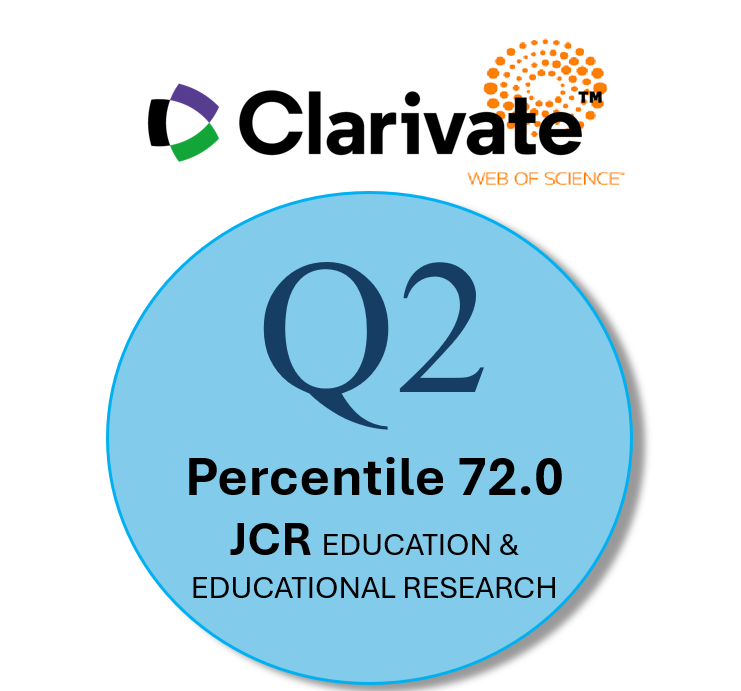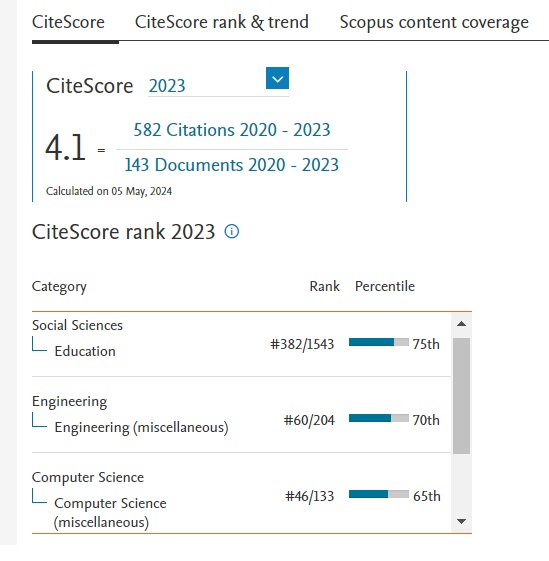La realidad virtual y su efecto en la habilidad espacial: un caso de estudio enfocado en la enseñanza de la geometría descriptiva
Resumen
Este estudio describe un caso de estudio sobre el uso de la realidad virtual en la enseñanza de la geometría descriptiva para estudiantes de ingeniería. El objetivo fue desarrollar una experiencia de aprendizaje con la realidad virtual que mejore la habilidad espacial, se utilizó un entorno no inmersivo 3D con el propósito de facilitar la representación bidimensional en la intersección de sólidos. Este trabajo cuasiexperimental utilizo un primer grupo definido como grupo experimental que participo en un taller sobre la intersección de poliedros y la intersección de superficies de revolución utilizando la realidad virtual como medio para interactuar con los sólidos interceptados, mientras que un segundo grupo, el grupo control desarrollo los mismos temas con imágenes bidimensionales de los sólidos interceptados. El instrumento de evaluación midió las dimensiones de rotación mental y plegado mental, este fue aplicado a ambos grupos al inicio y al término del taller, logrando medir su habilidad espacial para la transformación rígida y no rígida de objetos. El análisis estadístico permitió identificar una diferencia significativa entre le grupo experimental y control, concluyendo que el taller desarrollado tuvo un efecto positivo en la habilidad espacial de los grupos de estudiantes que participan en el estudio.
Descargas
-
Resumen1117
-
PDF851
Citas
Alghazi, S. S., Kamsin, A., Almaiah, M. A., Wong, S. Y., & Shuib, L. (2021). For Sustainable Application of Mobile Learning: An Extended UTAUT Model to Examine the Effect of Technical Factors on the Usage of Mobile Devices as a Learning Tool.
Sustainability 2021, Vol. 13, Page 1856, 13(4), 1856. https://doi.org/10.3390/SU13041856
Allcoat, D., & Von Mühlenen, A. (2018). Learning in virtual reality: Effects on performance, emotion and engagement. Research in Learning Technology, 26. https://doi.org/10.25304/rlt.v26.2140
Ayala Alvarez, F. J., Blazquez Parra, E. B., & Tubio Montes, F. (2017). Improving graphic expression training with 3D models. Journal of Visualization, 20(4), 889–904. https://doi.org/10.1007/S12650-017-0424-8
Brailov, A. Y. (2016). Engineering graphics : theoretical foundations of engineering geometry for design (Springer (ed.); Springer). Springer.
Burte, H., Gardony, A. L., Hutton, A., & Taylor, H. A. (2019). Knowing when to fold ’em: Problem attributes and strategy differences in the Paper Folding test. Personality and Individual Differences, 146, 171–181. https://doi.org/10.1016/J.PAID.2018.08.009
Caissie, A. F., Vigneau, F., & Bors, D. A. (2009). What does the Mental Rotation Test Measure? An Analysis of Item Difficulty and Item Characteristics. The Open Psychology Journal, 2(1), 94–102. https://doi.org/10.2174/1874350100902010094
Cantón Enríquez, D., Jesús, J., Pimentel, A., Ángel Hernández López, M., Santiago, O., & García, N. (2017). Uso didáctico de la realidad virtual inmersiva con interacción natural de usuario enfocada a la inspección de aerogeneradores. Apertura (Guadalajara, Jal.), 9(2), 8–23. https://doi.org/10.32870/AP.V9N2.1049
Checa, D., & Bustillo, A. (2020). A review of immersive virtual reality serious games to enhance learning and training. Multimedia Tools and Applications, 79(9–10), 5501–5527. https://doi.org/10.1007/S11042-019-08348-9
Del Cerro-Velázquez, F., & Lozano-Rivas, F. (2019). Ecourban Technical Project supported by ICT for STEM learning (Technical Drawing) and the consolidation of SDG in classroom. Revista de Educación a Distancia, 19(60). https://doi.org/10.6018/RED/60/04
Fawns, T. (2018). Postdigital Education in Design and Practice. Postdigital Science and Education 2018, 1(1), 132–145. https://doi.org/10.1007/S42438-018-0021-8
Harris, J., Hirsh-Pasek, K., & Newcombe, N. S. (2013). Understanding spatial transformations: Similarities and differences between mental rotation and mental folding. Cognitive Processing, 14(2), 105–115. https://doi.org/10.1007/S10339-013-0544-6
Hegarty, M. (2010a). Components of Spatial Intelligence. Psychology of Learning and Motivation - Advances in Research and Theory, 52(C), 265–297. https://doi.org/10.1016/S0079-7421(10)52007-3
Hegarty, M. (2010b). Components of Spatial Intelligence. Psychology of Learning and Motivation - Advances in Research and Theory, 52(C), 265–297. https://doi.org/10.1016/S0079-7421(10)52007-3
Hernández-Sampieri, R., & Mendoza, C. (2018). Metodología de la investigación: las rutas cuantitativa, cualitativa y mixta. In Mc Graw Hill (Vol. 1, Issue Mexico).
Kaygorodtseva, N. (2012). The modernization of the rate of descriptive geometry. The Journal of Polish Society for Geometry and Engineering Graphics, 23, 7–10.
Kayode, D. J., Alabi, A. T., Sofoluwe, A. O., & Oduwaiye, R. O. (2019). Problems and Challenges of Mobile Learning in Nigerian University System. In Handbook of Mobile Teaching and Learning. Springer Berlin Heidelberg. https://doi.org/10.1007/978-3-642-41981-2_135-1
König, J., Jäger-Biela, D. J., & Glutsch, N. (2020). Adapting to online teaching during COVID-19 school closure: teacher education and teacher competence effects among early career teachers in Germany. European Journal of Teacher Education, 43(4), 608–622. https://doi.org/10.1080/02619768.2020.1809650/FORMAT/EPUB
Krasovskaya, N. I., Bauer, N. V., Shusharina, I. V., & Romanova, A. A. (2018). Formation of spatial thinking of future engineers on the basis of fundamental graphics training. Journal of Mechanical Engineering Research and Developments, 41(4), 62–65. https://doi.org/10.26480/JMERD.04.2018.62.65
Kuder, G. F., & Richardson, M. W. (1937). The theory of the estimation of test reliability. Psychometrika 1937 2:3, 2(3), 151–160. https://doi.org/10.1007/BF02288391
Logan, T., & Lowrie, T. (2017). Gender perspectives on spatial tasks in a national assessment: a secondary data analysis. Research in Mathematics Education, 19(2), 199–216. https://doi.org/10.1080/14794802.2017.1334577
Meyer, O. A., Omdahl, M. K., & Makransky, G. (2019). Investigating the effect of pre-training when learning through immersive virtual reality and video: A media and methods experiment. Computers & Education, 140, 103603. https://doi.org/10.1016/J.COMPEDU.2019.103603
Moll-Khosrawi, P., Falb, A., Pinnschmidt, H., Zöllner, C., & Issleib, M. (2021). Virtual reality as a teaching method for resuscitation training in undergraduate first year medical students during COVID-19 pandemic: a randomised controlled trial. https://doi.org/10.1186/s12909-022-03533-1
Ñaupas Paitán, H., Palacios Vileta, J. J., Romero Delgado, H. E., & Valdivia Dueñas, M. R. (2018). Metodología de la investigación cuantitativa-cualitativa y redacción de la tesis. In Ediciones de La U (Vol. 7, Issue 2). 2018. https://www.buscalibre.pe/libro-metodologia-de-la-investigacion-cuantitativa-cualitativa-y-redaccion-de-la-tesis-5-edicion/9789587628760/p/50606399
Radianti, J., Majchrzak, T. A., Fromm, J., & Wohlgenannt, I. (2020). A systematic review of immersive virtual reality applications for higher education: Design elements, lessons learned, and research agenda. Computers and Education, 147. https://doi.org/10.1016/J.COMPEDU.2019.103778
Shi, T., & Blau, E. (2020). Contemporary Theories of Learning and Pedagogical Approaches for All Students to Achieve Success (pp. 20–37). https://doi.org/10.4018/978-1-7998-4036-7.ch002
Slavova, Y., & Mu, M. (2018). A Comparative Study of the Learning Outcomes and Experience of VR in Education. 25th IEEE Conference on Virtual Reality and 3D User Interfaces, VR 2018 - Proceedings, 685–686. https://doi.org/10.1109/VR.2018.8446486
UNESCO. (2018). UNESCO ICT Competency Framework for Teachers. UNESCO. https://unesdoc.unesco.org/ark:/48223/pf0000265721
Van Nuland, S. E., Hall, E., & Langley, N. R. (2020). STEM crisis teaching: Curriculum design with e-learning tools. FASEB BioAdvances, 2(11), 631–637. https://doi.org/10.1096/FBA.2020-00049
Veletsianos, G., & Houlden, S. (2019). An analysis of flexible learning and flexibility over the last 40 years of Distance Education. Distance Education, 40(4), 454–468. https://doi.org/10.1080/01587919.2019.1681893
Wolfartsberger, J. (2019). Analyzing the potential of Virtual Reality for engineering design review. Automation in Construction, 104, 27–37. https://doi.org/10.1016/J.AUTCON.2019.03.018
Derechos de autor 2023 Revista de Educación a Distancia (RED)

Esta obra está bajo una licencia internacional Creative Commons Atribución-NoComercial 4.0.
Las obras que se publican en esta revista están sujetas a los siguientes términos:
1. El Servicio de Publicaciones de la Universidad de Murcia (la editorial) conserva los derechos patrimoniales (copyright) de las obras publicadas, y favorece y permite la reutilización de las mismas bajo la licencia de uso indicada en el punto 2.
2. Las obras se publican en la edición electrónica de la revista bajo una licencia Creative Commons Reconocimiento-NoComercial-SinObraDerivada 3.0 España (texto legal). Se pueden copiar, usar, difundir, transmitir y exponer públicamente, siempre que: i) se cite la autoría y la fuente original de su publicación (revista, editorial y URL de la obra); ii) no se usen para fines comerciales; iii) se mencione la existencia y especificaciones de esta licencia de uso.
3. Condiciones de auto-archivo. Se permite y se anima a los autores a difundir electrónicamente las versiones pre-print (versión antes de ser evaluada) y/o post-print (versión evaluada y aceptada para su publicación) de sus obras antes de su publicación, ya que favorece su circulación y difusión más temprana y con ello un posible aumento en su citación y alcance entre la comunidad académica. Color RoMEO: verde.














